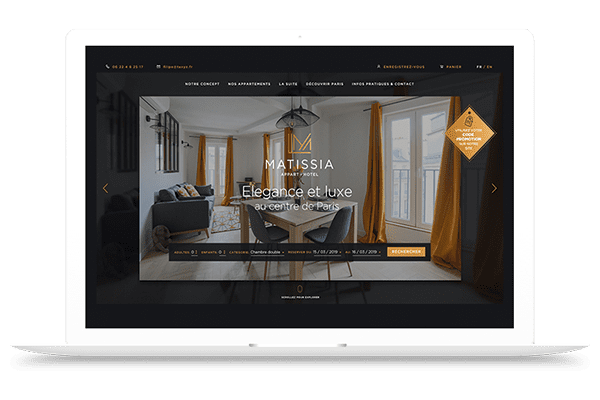Nowadays, most people book hotel rooms over the internet. From searching the web to confirming their choice, the online customer is faced with a tough decision and every detail counts. Your customers spend an average of 3 minutes on each hotel website, so that’s how long you’ve got to convince them to book at your establishment.
Your website must therefore be built to increase your conversion rate… But not everyone is an expert in the ways of the web! With over 35 years’ experience in hospitality, restaurant, wellness and spa activities, the Sequoiasoft web design agency hands you the keys to a hotel website that’s attractive, well-built, with quality content and geared towards conversion. Get ready to fill your booking schedule!
First up: visibility! The more visible your hotel website is, the greater chance you have of attracting visitors and generating bookings. So how do you achieve this?
 When a customer searches for a hotel room online, they’re going to type “hotel + place name” into a search engine. Logic dictates that they will then check out the first few search results. For your website to appear as high up as possible, you must work on the content of your website. It’s the essential component you cannot ignore, as the search engines will look at it to determine your site’s ranking in the search results. That means you need to think about placing keywords or expressions frequently used by your customers in the text of your site, and include them shrewdly in the content you write.
When a customer searches for a hotel room online, they’re going to type “hotel + place name” into a search engine. Logic dictates that they will then check out the first few search results. For your website to appear as high up as possible, you must work on the content of your website. It’s the essential component you cannot ignore, as the search engines will look at it to determine your site’s ranking in the search results. That means you need to think about placing keywords or expressions frequently used by your customers in the text of your site, and include them shrewdly in the content you write.
If we had to sum up and simplify the notion of keywords, we’d define them as ideas and subjects that define the content of your website or web page, and that may be searched for by online customers.
Example: “3* hotel Nice“. If your hotel meets these criteria (3* + Nice), this expression should be included in your content and SEO hotspots so the theme is associated to your site.
If you do it yourself, there are many tools available to help you choose the right keywords.
The bonus you get with Sequoiasoft is that we’re always working on keywords linked to your business (e.g. hotel, 4 star hotel, hotel with pool, hotel in Paris, hotel with spa, charming hotel), then we design “Surrounding area” pages that serve the local SEO (e.g. what to see and do near the hotel, the best spots, what to do in Paris, etc.) in order to offer multiple paths to your website.
In addition, the content on your website will allow you to respond to your customers’ needs and frequently asked questions, and encourage them to book with you. This will strengthen your hotel’s serious professional image.
Without going into detail – you already have a lot to think about – we’ll just give you some quick pointers. It’s vital that you optimise what are called the “SEO hotspots” of your website. This term denotes the areas that are looked at most by users but above all by search engines. What are they?
Need a hand with your SEO? You can get help from a digital agency that specialises in the hospitality industry, such as Sequoiasoft.
Search engines and customers love new content, so update your content regularly to improve your ranking and attract more customers. Don’t forget to update your tourist tax rates, reception opening times, new facilities, new sales and marketing offers, information about nearby activities, etc. The more dynamic the content of your hotel website, the better! Be aware that there are systems for communicating the opening of bookings and special offers:
Our advice, as a specialist web design agency for hotels in France: the “blog” or “news” page must be fed regularly. We advise you to include one in your website as it will have a strong impact on your local and long tail SEO. In this section, you can write articles about news items relevant to your industry, introduce your team, talk about seasonal events, local partnerships (with restaurants for example), new features of your property, etc. This section is also where you can work on your linking with partner sites.
To stand out from your competitors, the content you write must be different and not be copy & pasted from similar pages (there’s a Google algorithm that detects duplicated content, so this will work against you). Your content must be a good representation of your business and offer something of value to customers. In addition, your articles must be built strategically, discussing different themes with carefully chosen keywords to improve your SEO. Again, close attention must be paid to Title tags, the meta description and even the URL (the hotspots described above).

Though aesthetics are generally a matter of taste, this is not the case with your website, which must adhere to specific rules in terms of the customer journey and overall look. Let’s expand on that…
First of all, make sure your website’s architecture is built to facilitate the customer journey. Usually a quick update or “fresh lick of paint” is not enough, because technologies and trends evolve (such as booking using a smartphone), customers’ browsing habits change and site security threats grow (leading to the introduction of HTTPS and 3D Secure for online payments, for example). For all these reasons, we estimate that a website’s life cycle is generally between 3 and 5 years. In addition, a well-organised site structure is important for the search engine robots to easily understand the page content.
Commercially speaking, you also risk losing out in the rankings, because search engines like Google tend to highlight websites that are frequently updated, both in content and in technical terms. Your website is the entrance door to your establishment… so it must be easy to find and make you want to go in!
You just need to ask yourself the right questions:
Finally, your website must meet certain technical requirements. If your content is of high quality, both in substance and in form, but the experience is poor, the customer will not be satisfied and will not book. Think about the following:
The bonus with Sequoiasoft: factoring all of this in requires a certain level of organisation and experience. In our case, we first look at our client’s site structure, proposing a clear framework with all the different pages and levels. Then we build the main pages using zoning, indicating the position of each component on the page (photos, text, titles, effects, etc.) while taking into account SEO criteria.
In order for your website design to let your hotel’s image shine through, you must create a graphic charter, choose high-quality images and a design for easy browsing, whilst shining a light on your property’s charm. Show off your décor, your best marketing and hospitality assets, introduce your team, but be careful not to overload the pages to ensure a pleasant read.
The bonus with Sequoiasoft: when we build a website, once we’ve validated the zoning and architecture, we put together mock-ups to validate the visual design and offer you a website in your image! Our websites are 100% tailor-made and each client’s case is unique.
As for the content, there are different ways of presenting it: here are a few examples that we’ve found to work well, having designed dozens of hotel websites:

The ultimate goal of your website is to generate direct bookings by offering up-to-date deals and prices, and slotting these bookings directly into your PMS. When dealing with a web design agency that’s part of one of the biggest management software companies in France, all these aspects are perfectly mastered, making our hotel clients’ lives easier (as they often point out)! A website with a built-in hotel booking engine means:
Your website is also a precious ally when it comes to maintaining that link with your clientèle. For your guests to become loyal customers, you must build up a solid relationship. Once the booking has been made through your website, a new record appears in your customer database and you can then send emails to guests to prepare their stay, record their satisfaction, offer a discount or even give them your latest news. Once again, the link will be made directly to your hotel management software, for example Asterio or Winhôtel neo, and will optimise these tasks.
Our advice as a hotel website expert: offer downloadable documents (hotel flyer, activities on offer in the region, etc.). This will allow you to get the contact details of new prospects.
Another solution is to rely on automation tools built directly into your website.
The hospitality sector has its specific challenges and requirements, such as the ability to connect your website with your hotel management application. This might seem complicated, but to avoid spending lots of time or losing data, don’t hesitate to call on a digital agency that’s used to handling the connection between website and management software. Note however: if you go with an online marketing agency to create your website, be wary of the pricing. Creating a website is a big investment that can represent a barrier for smaller organisations.
Certain web design agencies will offer deals, but make sure they make you the owner of your hotel website and domain name – this is fundamental!
Distribute / 26 May, 2021
Hoteliers, restaurant owners, hotel-restaurants, hotel-spas… Asterio’s 100% web-based software combines all the features you are looking for to make your daily life easier and optimise your performances. Whatever your business profile, whatever your activity, Asterio brings you management and marketing solutions in a simplified and intuitive way!
Need a software for increase your sales and simplify your management?
Are you looking for a solution to market and manage all your activities (accommodation, catering, Spa, boutique, etc.)?
Contact us and ask for a demo of Asterio our full web PMS.

Support available from 7am to 10pm, 7 days a week

100% made in France Software